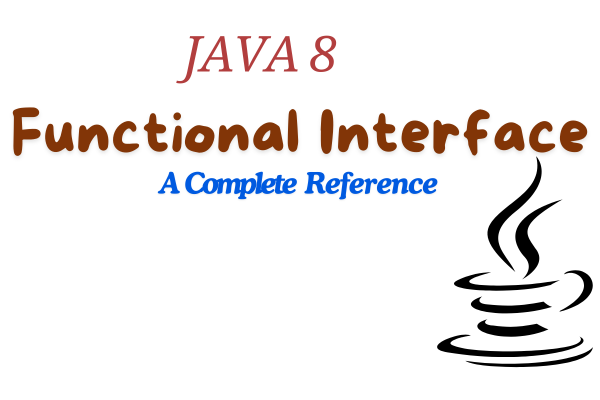Java 8 brought a host of new features designed to enhance code clarity and brevity. One of the key innovations is the functional interface, which is essential for utilizing lambda expressions and stream processing. This guide will delve into the definition of it, its various types, usage scenarios, and methods for implementation.
Table of Contents
What is a Functional Interface?
A functional interface is defined as an interface containing a single abstract method. However, it may also have multiple default or static methods. The existence of just one abstract method permits the use of lambda expressions, enabling the inline implementation of the interface, which contributes to cleaner and more succinct code.
While it is commonly marked with the @FunctionalInterface annotation, this is not mandatory. This annotation serves to prevent the inadvertent addition of abstract methods, which could compromise its status as a functional interface.
Key Characteristics:
- Exactly one abstract method.
- It is allowed to include multiple static or default methods.
- Supports lambda expressions.
- Optionally annotated with
@FunctionalInterfaceto enforce its functional nature.
Example:
@FunctionalInterface
interface MyFunctionalInterface {
void doSomething(); // Only one abstract method allowed
}Types of Functional Interfaces
Java 8 offers a variety of predefined interfaces that are functional and located in the java.util.function package. These interfaces are designed to handle common programming tasks, minimizing the necessity for creating custom interfaces.
Here are the major types of it:
- Consumer: It takes only one input and doesn’t return any result.
@FunctionalInterface public interface Consumer<T> { void accept(T t); } - Supplier: Returns a result and takes no input.
@FunctionalInterface public interface Supplier<T> { T get(); } - Predicate: Accepts a parameter and gives a boolean outcome.
@FunctionalInterface public interface Predicate<T> { boolean test(T t); } - Function: Accept one argument and return a result.
@FunctionalInterface public interface Function<T, R> { R apply(T t); } - BiFunction: Takes two arguments and returns a result.
@FunctionalInterface public interface BiFunction<T, U, R> { R apply(T t, U u); } - UnaryOperator: A distinct type of Function in which both the input and output types are identical.
@FunctionalInterface
public interface UnaryOperator<T> extends Function<T, T> { } - BinaryOperator: A specific variant of BiFunction where the types of the two inputs and the output are the same.
@FunctionalInterface
public interface BinaryOperator<T> extends BiFunction<T, T, T> { }
Implementation of Functional Interfaces
There are several methods for implementation, such as utilizing anonymous classes, lambda expressions, and method references.
a) Anonymous Classes
Prior to Java 8, interfaces with a single method were generally implemented using anonymous inner classes.
MyFunctionalInterface myFunc = new MyFunctionalInterface() {
@Override
public void doSomething() {
System.out.println("Doing something in an anonymous class.");
}
};
myFunc.doSomething();b) Lambda Expressions
With Java 8, lambda expressions simplify this implementation. A lambda expression offers a compact means of representing instances of functional interfaces. Given that it contains just one abstract method, the lambda can be directly associated with that method.
MyFunctionalInterface myFunc = () -> System.out.println("Doing something using a lambda expression.");
myFunc.doSomething();c) Method References
Another addition in Java 8 is method references, allowing direct references to methods by their names. This enhances code readability significantly.
class Example {
public static void printMessage() {
System.out.println("Doing something using a method reference.");
}
}
MyFunctionalInterface myFunc = Example::printMessage;
myFunc.doSomething();Predefined Functional Interfaces in Action
Here’s a practical illustration of how to utilize it.
import java.util.function.*;
public class FunctionalInterfaceExample {
public static void main(String[] args) {
// Example of Consumer
Consumer<String> printConsumer = message -> System.out.println(message);
printConsumer.accept("Hello from Consumer!");
// Example of Supplier
Supplier<Double> randomSupplier = () -> Math.random();
System.out.println("Random number: " + randomSupplier.get());
// Example of Predicate
Predicate<Integer> isEven = number -> number % 2 == 0;
System.out.println("Is 4 even? " + isEven.test(4));
// Example of Function
Function<String, Integer> lengthFunction = str -> str.length();
System.out.println("Length of 'Functional': " + lengthFunction.apply("Functional"));
// Example of BiFunction
BiFunction<Integer, Integer, Integer> addFunction = (p1, p2) -> p1 + p2;
System.out.println("Sum of 1 and 5: " + addFunction.apply(1, 5));
}
}Custom Functional Interfaces
Alongside the predefined interfaces, you have the option to develop custom interfaces that will be functional and tailored to meet specific requirements.
@FunctionalInterface
interface Calculator {
int calculate(int a, int b);
}
public class CustomFunctionalInterfaceExample {
public static void main(String[] args) {
// calculate method is being implemented by lambda expression
Calculator adder = (a, b) -> a + b;
System.out.println("Sum: " + adder.calculate(10, 20));
Calculator multiplier = (a, b) -> a * b;
System.out.println("Product: " + multiplier.calculate(10, 20));
}
}Benefits of Functional Interfaces
- Concise Code: Lambda expressions reduce boilerplate code, especially in the case of single-method interfaces.
- Readability: Code using it with lambdas or method references is more readable and easier to maintain.
- Parallel and Stream Processing: They are essential for Java Streams, which enable parallel processing, collection manipulation, and efficient data handling.
- Interoperability: They bring Java closer to functional programming paradigms, enhancing the language’s versatility.
Common Functional Interface Use Cases
- Event Handling: Functional interfaces are integral to the event-driven programming model, particularly in frameworks such as JavaFX or Swing.
- Stream API: They play a crucial role in the Java Stream API for efficiently filtering, mapping, and collecting data.
- Concurrency: Lambdas and functional interfaces can be used in concurrent programming scenarios, making it easier to write multithreaded code.
Conclusion
Java 8 functional interfaces significantly transform how we write code. With the use of lambdas, method references, and streams, developers can enhance the efficiency and readability of their programs. Grasping these functional interfaces and their role within Java’s ecosystem is crucial for contemporary Java development. They are also one of the favorite topics interviewers focus on during Java interviews. You can check out the top Java 8 interview questions and answers here.


2 thoughts on “Functional Interfaces in Java 8: A Detailed Guide”